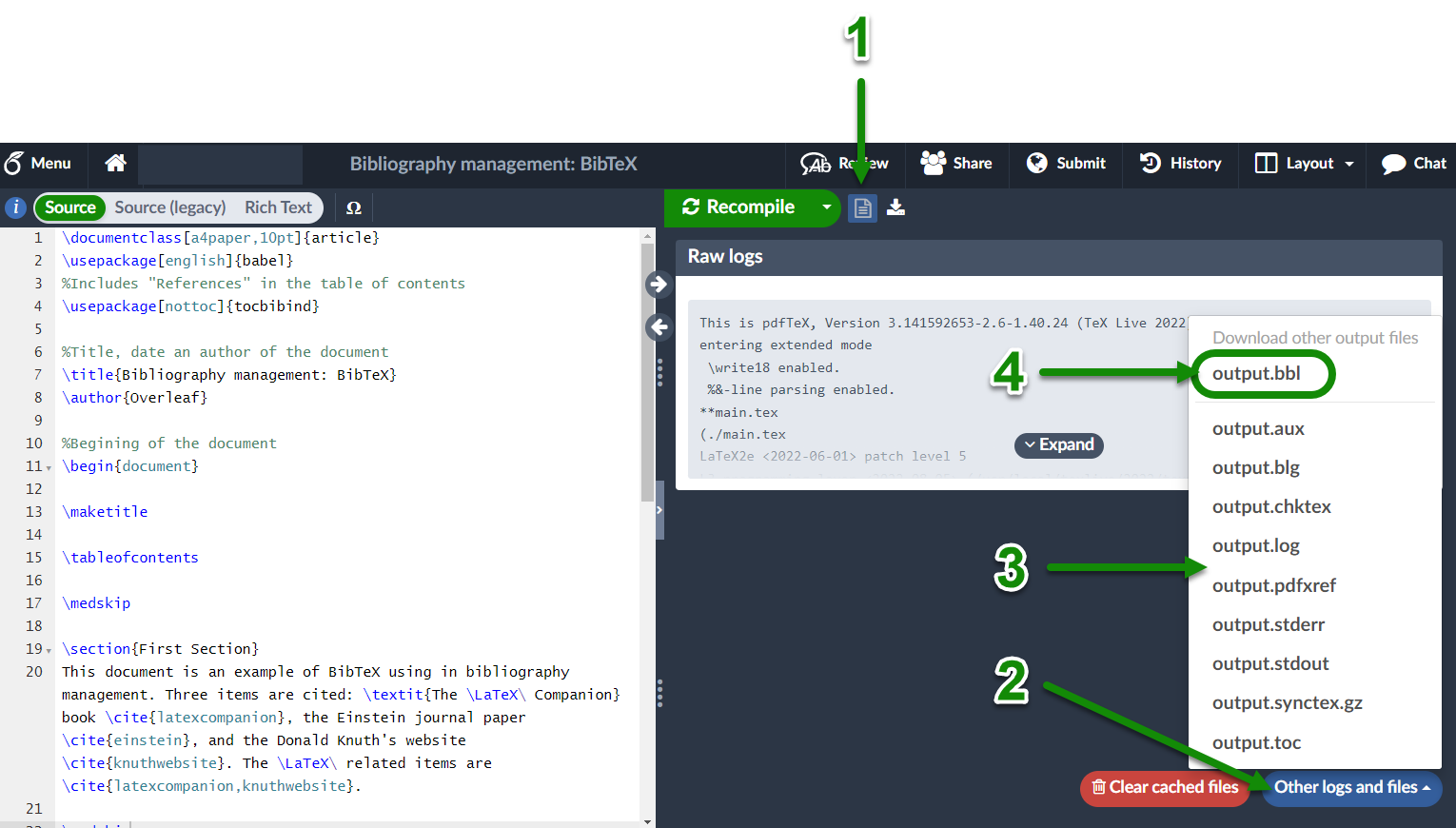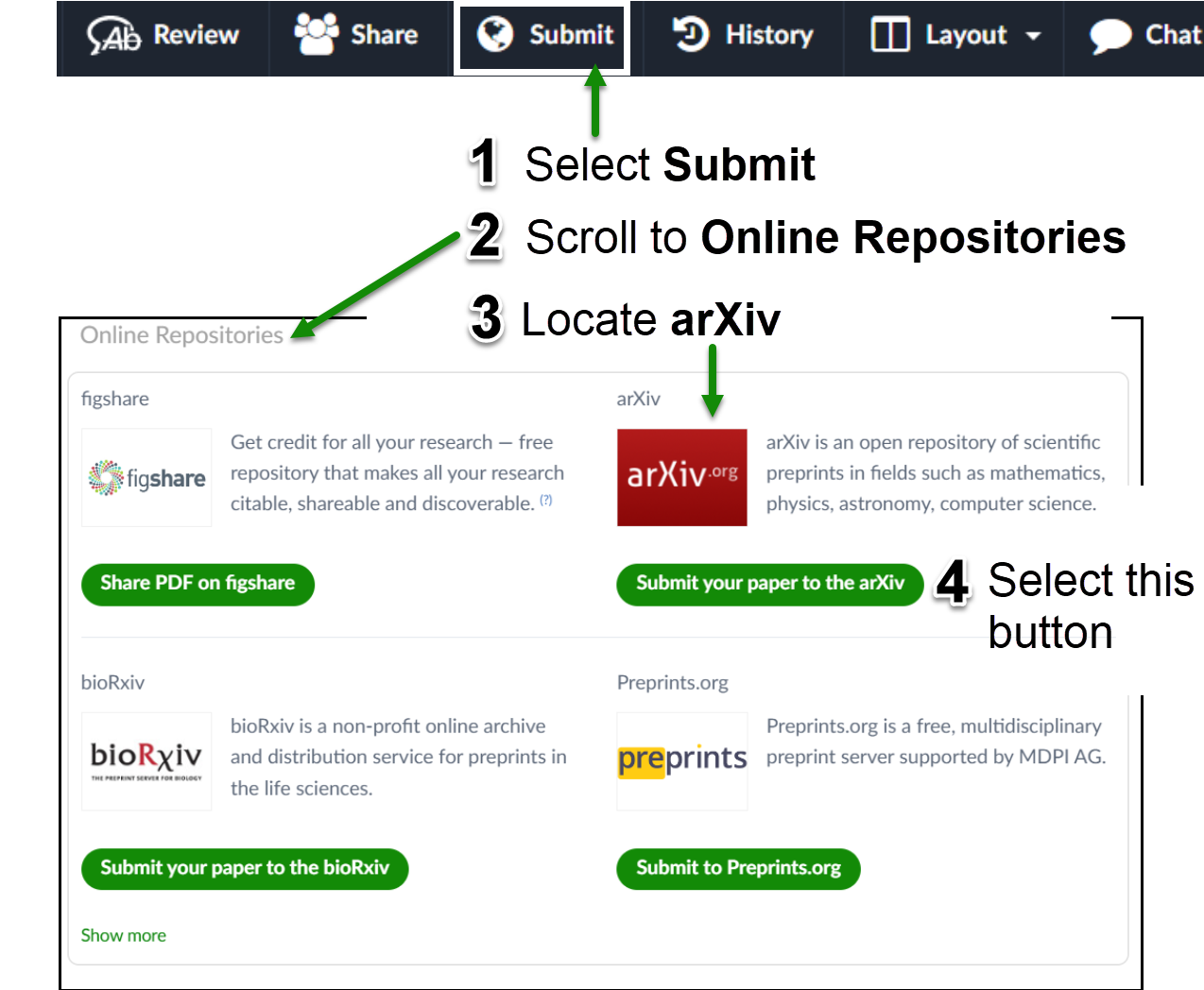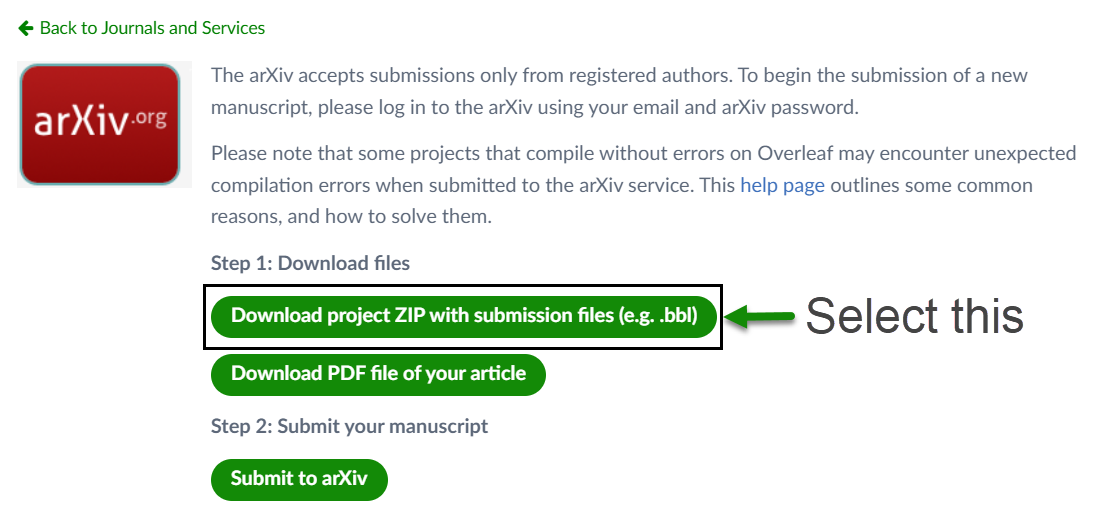The journal says "don't use BibTeX; paste the contents of the .bbl file into the .tex file". How do I do this on Overleaf?
Some publishers use article-submission systems that only compile the submitted .tex file(s) in a single pdflatex or latex run—i.e., they don’t run BibTeX. In such cases, the publisher’s guidelines might ask authors (whose manuscripts use BibTeX) to paste the contents of the .bbl file into the article’s main .tex file.
This article shows two ways to access the generated .bbl file contained in your Overleaf project and provides a short video demonstrating downloading a .bbl file and pasting its content into the project’s main .tex file.
Downloading files from the cache
Files created during compilation are stored in the project’s cache, including any .bbl files.
Follow these steps to download a file contained in the cache:
- click the file icon (
 ) beside the Recompile button;
) beside the Recompile button; - scroll down and select Other logs and files;
- a list of files in the cache is presented;
- select output.bbl to download it.

As demonstrated in the short video, comment out the line \bibliography{...} within your .tex file on Overleaf, then paste the contents of the .bbl file downloaded from the cache.
Downloading the source, including the .bbl file
It’s also possible to download the source code with the .bbl included. Use the following steps to do that:
- select Submit from the menu above the PDF preview window;
- scroll down to Online Repositories;
- locate arXiv;
- select Submit your paper to the arXiv

- within the pop-up window select Download project ZIP with submission files (e.g. .bbl);

- extract the
.bblfile from the downloaded ZIP file; - (see video) comment out the line
\bibliography{...}within your.texfile on Overleaf, then paste the contents of the.bblfile.
The project is now ready to be submitted to the journal, complying with any requirements for the contents of the .bbl file to be pasted into the article’s main .tex file.
Video
The following video demonstrates downloading a .bbl file and pasting its contents into the project’s main .tex file.
Overleaf guides
- Creating a document in Overleaf
- Uploading a project
- Copying a project
- Creating a project from a template
- Using the Overleaf project menu
- Including images in Overleaf
- Exporting your work from Overleaf
- Working offline in Overleaf
- Using Track Changes in Overleaf
- Using bibliographies in Overleaf
- Sharing your work with others
- Using the History feature
- Debugging Compilation timeout errors
- How-to guides
- Guide to Overleaf’s premium features
LaTeX Basics
- Creating your first LaTeX document
- Choosing a LaTeX Compiler
- Paragraphs and new lines
- Bold, italics and underlining
- Lists
- Errors
Mathematics
- Mathematical expressions
- Subscripts and superscripts
- Brackets and Parentheses
- Matrices
- Fractions and Binomials
- Aligning equations
- Operators
- Spacing in math mode
- Integrals, sums and limits
- Display style in math mode
- List of Greek letters and math symbols
- Mathematical fonts
- Using the Symbol Palette in Overleaf
Figures and tables
- Inserting Images
- Tables
- Positioning Images and Tables
- Lists of Tables and Figures
- Drawing Diagrams Directly in LaTeX
- TikZ package
References and Citations
- Bibliography management with bibtex
- Bibliography management with natbib
- Bibliography management with biblatex
- Bibtex bibliography styles
- Natbib bibliography styles
- Natbib citation styles
- Biblatex bibliography styles
- Biblatex citation styles
Languages
- Multilingual typesetting on Overleaf using polyglossia and fontspec
- Multilingual typesetting on Overleaf using babel and fontspec
- International language support
- Quotations and quotation marks
- Arabic
- Chinese
- French
- German
- Greek
- Italian
- Japanese
- Korean
- Portuguese
- Russian
- Spanish
Document structure
- Sections and chapters
- Table of contents
- Cross referencing sections, equations and floats
- Indices
- Glossaries
- Nomenclatures
- Management in a large project
- Multi-file LaTeX projects
- Hyperlinks
Formatting
- Lengths in LaTeX
- Headers and footers
- Page numbering
- Paragraph formatting
- Line breaks and blank spaces
- Text alignment
- Page size and margins
- Single sided and double sided documents
- Multiple columns
- Counters
- Code listing
- Code Highlighting with minted
- Using colours in LaTeX
- Footnotes
- Margin notes
Fonts
Presentations
Commands
Field specific
- Theorems and proofs
- Chemistry formulae
- Feynman diagrams
- Molecular orbital diagrams
- Chess notation
- Knitting patterns
- CircuiTikz package
- Pgfplots package
- Typesetting exams in LaTeX
- Knitr
- Attribute Value Matrices
Class files
- Understanding packages and class files
- List of packages and class files
- Writing your own package
- Writing your own class